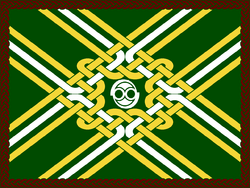Hadlow
 | |
| Official language | Oruk-Hadl |
|---|---|
| Capital | Tikahameh |
| Government | Theocracy |
The Sacred Alluvial Lands of Hadlow (Oruk-Hadl: Hadlow n'Melthrune [hɒd.lo nᵊ.mɛl.θɹ̠ʉ.nə]), commonly referred to as Hadlow, is a theocratic tribal confederation of city-states that inhabit the Caledon (Oruk-Hadl: Zalsee) river delta, which cuts across the arid steppe lands of Orbesti. Hadlow was founded in 1 HE by the High Priestess Leocor Hadlit, after leading several members of the Oruk-Mai and Oruk-Fala tribes southward from Red Lake (Oruk-Hadl: Orsee) following the destruction of the Mai Empire. Hadlow remained a relative technological backwater and political unknown until the area was explored and claimed by the Britannic Empire in 2587 HE, who renamed the Zalsee delta as the Virgin Islands. Britannic, and later Nova England and Hamland influence in the region did not last, however both of these nations opened up Hadlow to the wider world and introduced the heavily agrarian tribes to modern technology and international trade. The modern state of Hadlow has struggled to find a balance between such rapid change and maintaining their traditional Oruk culture, an issue the people hope will be solved by their new head of state, the High Priestess of Lillon, Leocor Sukit.
Etymology
Hadlow n'Melthrune is named after the former High Priestess of Neneveh, Leocor Hadlit (IPA: [li.o.koɹ̠ hɒd.liʃ]), who lived between 3844 ME and 18 HE, and is generally credited with leading the Zalsee Migration from the Orsee (Red Lake) to the Zalsee (Caledon) river delta. The Oruk-Hadl term n'Melthrune (IPA: [nᵊ.mɛl.θɹ̠ʉ.nə]) is a pairing of the words melth and rune. Melth refers to a type of red alluvial soil that is rich in nutrients and produces bountiful crops. Melth is deposited in the Zalsee delta during the annual flood season, an event considered crucial to the survival of the Oruk-Hadl people and their agrarian lifestyle. For this reason, melth is considered sacred and is associated with the goddess of agriculture and fertility, Gaya. The Oruk-Hadl term rune literally translates to "can be found," and is generally used in reference to the location of a commodity or people. n'Melthrune would then approximately translate into English as the "Sacred Alluvial Lands," with the preposition n being a plural indicator.
History
Oruk race and the Mai Empire
Zalsee Migration
Early Oruk-Hadl society
Callo occupation
Pax Oruk-Hadl
Industrialization and globalization
Geography
Hadlow is located at the mouth of the Zalsee (Caledon) river, the primary waterway in the semi-arid Orbesti region of Keltia. The mouth of Zalsee where Hadlow is located is a narrow alluvial plain and river delta, hemmed in by a high plateau on either side. Snowmelt causes the Zalsee to crest every 8-9 months, which is responsible for depositing rich sediments from Orsee (Red Lake) and Lake Tulsa onto this alluvial plain (an event registered as the beginning of a Qarnoan year). These deposited sediments, called melth by the native Oruk-Hadl, is highly rich in phosphate and nitrates, vital plant nutrients, thus allowing Hadlow to maintain an high density, agrarian society in an otherwise hostile environment.
Demographics
Population
Language
Religion
Government and politics
Structure and function of the state
Political divisions
Parties and political groups
Foreign relations
Military
Hadlow's military is a defensive force composed of a separate navy and army, both of which are underarmed and lack adequate training and funding. Hadlow's military was created after the Callo occupation ended in 675 HE by the former High Priestess of Neneveh, Leocor Hadlit IV. The eight temple cities of Hadlow, already walled urban centers as part of an expanding flood control network, were further developed into a series of defensive fortifications. A large navy of 264 galleys and a further 8 galleasses were ordered, of which 51 galleys and 3 galleasses remain in operational service. Bronze and brass swords, spears and arrows were the primary armament of Hadlow's armed forces, which were further subsidized by ballistas and handgonnes after the discovery of gunpowder in the 2300s HE. Nearly two millennia of isolation from the most of the outside world prevented Hadlow from developing a modern military, and the nation was caught off-guard by the sudden appearance of steel battleships, machine guns, aircraft and tanks when the first foreigners since the Callo dynasty arrived in Hadlow in 2587 HE.
The sudden arrival of technology thousands of years more advanced than anything the Oruk-Hadl people had ever seen before prompted the government to modernize Hadlow's military. The army was re-equipped with foreign weapons, and the navy underwent developing modern steel warships. The first of these ships, the HML Hsema, was commissioned after much delay in 2672 HE and became the first Oruk-Hadl ship to travel past the Zalsee delta, circumnavigating Micras in 2674 HE. Several more ships, including the massive dreadnought HML Subiriv, are currently under construction. The modernization of Hadlow's military also saw the renovation and upgrading of most of the old fortification systems with modern coastal artillery, torpedo and mine traps, and anti-aircraft guns and obstacles. Although the modernization efforts have certainly borne fruit, Hadlow is by no means on par with the majority of its neighbors, still lacking in tanks and other vehicles, aircraft, rockets, and WMDs.